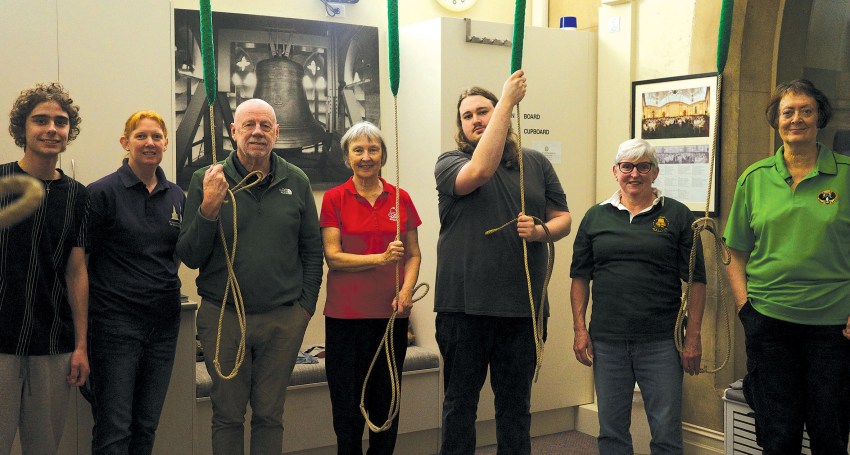Ringing in talent, new and old
Events
A joyful peal of bells rang through the streets of Adelaide on Friday June 7, causing busy city workers to stop in their tracks to look up at St Francis Xavier’s Cathedral.

There, inside the bell tower, a group gathered as part of the Australian and New Zealand Association of Bellringers (ANZAB) annual general meeting.
ANZAB was formed in 1962 to promote the art of change ringing across the two countries. Approximately 350 members ring at more than 70 bell towers across Australia and New Zealand.
Among the 100 bellringers who converged on Adelaide for the event was 18-year-old Luka Sostarko who flew in from Melbourne for the occasion.
Advertisement
Luka is part of a new generation of bellringers dedicated to preserving the art. He was drawn to bellringing when attending church with his father as a child.
“I became interested in the story of the Hunchback of Notre Dame and began to research how bells were rung in real life,” he says.
“Then I found out about change ringing.”
In a nutshell, change ringing is the traditional English art of ringing a set of tower bells in an intricate series of changes by pulling ropes attached to bell wheels.
Sounds simple? It’s not. It’s mathematical rather than musical and the nature of the mathematical permutations (different orderings in the ringing sequence) is complicated and takes a great deal of time, dedication and rhythm to master.
“I think people are often surprised that bells are still rung manually and especially that the mathematical side of the methods is so complicated,” Luka says.
“People often just think you pull a rope up and down, but it is much more complicated and interesting.”
Watching bellringers in action is something to which few people are privy. It’s quite a beautiful sight.
The bells are arranged so that the ropes hang down in a circle, starting with the smallest bell and finishing with the largest. A ring of bells usually consists of five, six, eight, 10 or 12 bells, and each bell needs one ringer to control it.
Adelaide-based ringer Patrick Meyer was thrilled to have fellow enthusiasts in South Australia for the four-day event.
“It’s a great opportunity to ring more complicated things that we don’t get to with our regular bands,” Patrick says.
“This bell weighs about one and a half tonnes,” the 22-year-old says as he reaches for his rope.
“We ring each bell precisely. Essentially, a method is a memorised pattern.”
Patrick also fell in love with bell ringing at an early age.
“I was at a miniature railway with my grandmother Lesley McLean who is a (Anglican) priest,” he says.
“She started a conversation with a man who had an image of a bell on his t-shirt. He suggested I give bell ringing a try.”
Advertisement
That was just over 10 years ago, and the bug really bit.
“I was looking for a hobby and a place to belong, and I don’t tend to go for the more mainstream options.”
Adelaide Bellringers member Susan Tonkin also started bellringing after an interest in history led her to the niche hobby.
“I am a great fan of the novels by Dorothy L. Sayers, particularly the Lord Peter Wimsey mysteries,” she says.
“I read The Nine Tailors when I was at an impressionable young age, and it was gobsmacking. Like all detective novelists, she likes to be a subject expert on wherever her story is set, and The Nine Tailors is all about change ringing. I was just blown away and thought, ‘how wonderful to be able to do that’ but the book was set in England, and I never imagined it happened in Australia.”
A serendipitous encounter with a woman at a party changed all that.
“I was talking about this novel I’d been reading about bellringing and she said, ‘I’m a bell ringer, you should do it too’. This was 1981.”
More than four decades later, Susan can’t fathom the hours spent on her hobby.
“It takes determination and persistence. It took me months to be a respectable bell handler but I stuck with it and it is hugely satisfying.”
Susan says bellringing attracts a motley crew of different characters from a variety of backgrounds.
“It’s like any subculture,” she says.
“Some people collect model cars, play the ukulele or go to science fiction conventions…we ring bells.”
The main purpose of bellringing is to serve the church, but the group ring in many other settings, too.
“It’s the same with the organists and choristers,” Susan says.
“You take pride in what you do and the more complicated and challenging it gets, the more fun and satisfying it is. When you get together with other people who specialise in the same thing there’s a social life that goes with it, too.”
Patrick agrees. “The community is the good part of it. These are people I’ve known for half my life, so they’re friends more than anything.
“Other than that, the continued challenge of progressing and getting better is what keeps me in bellringing. There’s no end point to ringing; you can just keep getting better and learning more until the day your arms stop working.”
The bellringers do it for the love of it.
“We are volunteers for the church and civic buildings,” Patrick says.
“It’s more beneficial for us if the bells are maintained properly than it is for us to get paid.”
The ANZAB festival and AGM included a bellringing competition. General ringing sessions also took place at St Andrew’s Walkerville, St Cuthbert’s in Prospect, St Peter’s Cathedral, and Adelaide Town Hall.
On hand to oversee the gatherings were Adelaide Bellringers including bell tower captain Hannah Tayler and Phil Goodyer who was instrumental in the organisation and installation of St Francis Xavier’s Cathedral bells during the 1980s. Phil also increased the ringing capacity to 10 and 12 bell methods.
The number of young bellringers indicates a promising future.
“I keep ringing bells because it is a wonderful hobby away from a device,” Luka says.
“You work with a team every week and can continue to learn more and more complex methods, so there is always something new to learn and try. There’s a great sense of achievement when you ring a new method for the first time.”
More information at adelaidebellringers.org.au







